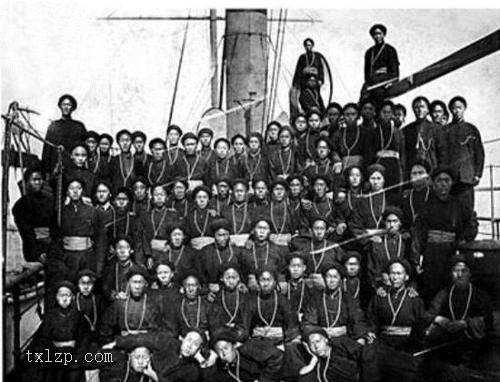Period:Ming dynasty Production date:1550-1600 (circa)
Materials:earthenware
Technique:glazed, painted, pierced, cold painted,
Subjects:musician
Dimensions:Height: 19.50 centimetres Length: 5 centimetres Depth: 5 centimetres
Description:
Green-and-amber-glazed earthenware funerary model of a drummer. This funerary model of a drummer stands on a two-tier square base. He rests both fists on the edge of the round drum which hangs out horizontally from his waist. He wears a short cross-over robe, glazed green with amber panels on either side, and has a conical hat with a brim and boots, which were both cold-painted. The drum has raised ribs with small studs at the upper and lower edges and the top is painted with a lotus flower. The figure is pierced through the unglazed base.
IMG
![图片[1]-figure BM-1938-0524.29-China Archive](https://chinaarchive.net/Ming dynasty/43/mid_00262538_001.jpg)
Comments:Harrison-Hall 2001:Model musicians are found in Ming burials at the vanguard of processions, either on horseback or on foot. They appear to proclaim the arrival of the occupant of the sedan chair. Interestingly they play a variety of rousing instruments, such as trumpets, pipes, horns, drums and cymbals, rather than the dulcimers or lutes which could have provided more relaxing entertainment. This drummer heralds the arrival of the tomb occupant. He is not an entertainer but a player of ritual or ceremonial rhythms.A very similar stone figure of a drummer was excavated from the tomb of Zhang Wenjin, who was buried in 1558 in Tongliang county, Sichuan. It was discovered placed within a group of musicians, playing trumpets and drums, at the head of a procession of model figures surrounding a sedan chair with bearers. Another stone figure of a drummer was excavated from Zhang’s wife’s tomb, dating to 1577. The present figure is similar to the earlier model, suggesting a date range of c. 1558-77.From Ming dynasty short stories we know that bands of drummers and other musicians marched before men of rank to announce their arrival on important ceremonial occasions. For example, a story published by Feng Menglong in Suzhou in 1620 as part of a compilation of tales in Stories Old and New, called in translation ‘The Lady who was a Beggar’, describes the arrival of Mo Zhi, the census officer, to meet his future bride, “… all complete with mandarin’s hat and girdle: he was dressed in red brocade and had gold ornaments in his cap, under him was a fine steed with decorated saddle and before him marched two bands of drummers and musicians”.
Materials:earthenware
Technique:glazed, painted, pierced, cold painted,
Subjects:musician
Dimensions:Height: 19.50 centimetres Length: 5 centimetres Depth: 5 centimetres
Description:
Green-and-amber-glazed earthenware funerary model of a drummer. This funerary model of a drummer stands on a two-tier square base. He rests both fists on the edge of the round drum which hangs out horizontally from his waist. He wears a short cross-over robe, glazed green with amber panels on either side, and has a conical hat with a brim and boots, which were both cold-painted. The drum has raised ribs with small studs at the upper and lower edges and the top is painted with a lotus flower. The figure is pierced through the unglazed base.
IMG
![图片[1]-figure BM-1938-0524.29-China Archive](https://chinaarchive.net/Ming dynasty/43/mid_00262538_001.jpg)
Comments:Harrison-Hall 2001:Model musicians are found in Ming burials at the vanguard of processions, either on horseback or on foot. They appear to proclaim the arrival of the occupant of the sedan chair. Interestingly they play a variety of rousing instruments, such as trumpets, pipes, horns, drums and cymbals, rather than the dulcimers or lutes which could have provided more relaxing entertainment. This drummer heralds the arrival of the tomb occupant. He is not an entertainer but a player of ritual or ceremonial rhythms.A very similar stone figure of a drummer was excavated from the tomb of Zhang Wenjin, who was buried in 1558 in Tongliang county, Sichuan. It was discovered placed within a group of musicians, playing trumpets and drums, at the head of a procession of model figures surrounding a sedan chair with bearers. Another stone figure of a drummer was excavated from Zhang’s wife’s tomb, dating to 1577. The present figure is similar to the earlier model, suggesting a date range of c. 1558-77.From Ming dynasty short stories we know that bands of drummers and other musicians marched before men of rank to announce their arrival on important ceremonial occasions. For example, a story published by Feng Menglong in Suzhou in 1620 as part of a compilation of tales in Stories Old and New, called in translation ‘The Lady who was a Beggar’, describes the arrival of Mo Zhi, the census officer, to meet his future bride, “… all complete with mandarin’s hat and girdle: he was dressed in red brocade and had gold ornaments in his cap, under him was a fine steed with decorated saddle and before him marched two bands of drummers and musicians”.
© Copyright
The copyright of the article belongs to the author, please keep the original link for reprinting.
THE END

![[Qing Dynasty] British female painter—Elizabeth Keith, using woodblock prints to record China from the late Qing Dynasty to the early Republic of China—1915-China Archive](https://chinaarchive.net/wp-content/uploads/2022/11/image-191x300.png)



